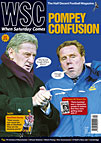 For 16 years, Scottish fans could read a football publication that didn’t begin and end in Glasgow. Archie MacGregor explains the rise and demise of his fanzine and the changes in the game in its lifetime
For 16 years, Scottish fans could read a football publication that didn’t begin and end in Glasgow. Archie MacGregor explains the rise and demise of his fanzine and the changes in the game in its lifetime
From December 1986 to September 2002, The Absolute Game (TAG) jinked its way through 60 issues about Scottish football in general and everything but the Old Firm in particular.
Without WSC there would have been no TAG. While a generation of supporters in Scotland will no doubt seize on this as priceless evidence for their pending damages claim in connection with the permanent impairment of their eyesight from trying to read early issues of both publications, it’s the simple truth. WSC wasn’t the first football fanzine I’d come across – a Scottish proto-type called Fitba’ Crazy which came and went in 1984 claimed that distinction – but it was the ignition key when it came to showing just how potent the genre could be when trying to connect with other supporters.
But while WSC provided a template for us and scores of others to build upon, the football landscape in Scotland was different in both stark and subtle ways. There was no European ban, no threat of ID cards and, largely in the aftermath of the drinks ban following the notorious 1980 Old Firm Scottish Cup final, hooliganism had been appropriated into a lower-profile, if still scary, sub-culture by the Casuals. Indeed, superficially Scottish football reaped untold benefits from the sorry state of the game south of the border – at least that’s the line we were sold when Graham Roberts, Mark Falco and Terry Hurlock, to name but a few, turned up to ply their trade at Ibrox in the wake of the self-styled “Souness revolution”.
Yet as a follower of a non-Old Firm club I looked upon it as a thoroughly miserable era. The clubs, the SFA and the League didn’t give a stuff about supporters. Office-holders such as Ernie Walker and Jim Farry seemed wilfully to enjoy goading ordinary folks about how unaccountable they were. And as for the media, well, even parts of the old Soviet bloc probably enjoyed greater freedom of expression when it came to sports coverage. There were only two clubs in town – and it wasn’t Brechin City and Albion Rovers.
Events at Ibrox and to a lesser extent Hearts, where Wallace Mercer was busy developing the cult of the businessman as the saviour of the modern game, sent a chill down the spine. There were unashamed pronouncements on the notion of fans as “consumers” and an embracing of the “greed is good” creed of the times. With TAG we would have loved to have fomented a counter-revolution, but trying to develop a community of like-minded, disenfranchised, slightly disillusioned but still passionate believers in the honest-to-goodness spirit of the game was a decent enough start.
We certainly seemed to tap into something. At its peak, TAG shifted just under 3,000 copies per issue and we always liked to think that the actual readership number was a healthy margin over that. It gradually became practice for the media in Scotland to recognise that supporters had a voice and often an articulate one at that. More than a few contributors moved on to the mainstream press to challenge the established orthodoxy and it was even known for features on Brechin City and Albion Rovers to appear. Debate over the introduction of a league pyramid system began to gain currency and our readers confirmed on a regular basis just how sickened the rest of us were with the sectarian baggage that came along with all things associated with the Old Firm. We worked closely with club-based fanzines on issues affecting them at a local level and, just to demonstrate that our thoughts on a “community” of supporters weren’t entirely fanciful, we witnessed the affirming sight of fans of many Scottish clubs joining forces with their counterparts at Hibernian to successfully beat off the much despised Mercer-led bid to merge Hearts and Hibs into some nonsensical Edinburgh super team and release acres of developable real estate.
Deliberately shunning the two biggest clubs in the country was never going to be a winning marketing strategy for TAG. Others with a lot more resources and publishing experience have repeatedly tried and failed to establish some kind of monthly Scottish football mag that sells on the high street. So when the usual life-cycle stuff about work commitments and families came along we had to gently let it go. It most definitely wasn’t a case of job done – too many familiar bugbears are still there: sectarianism, lack of reform of the league structure and a media that has become obsessed with ex-players, phone-ins and B-list celebs at the expense, once again, of really listening to fans. Despite it all, though, I remain curiously optimistic that the mission will go on – it must be something to do with the looming prospect of an Old Firm-free Scottish Cup final. As for a TAG comeback one day? Never, ever, say never.
From WSC 230 April 2006. What was happening this month